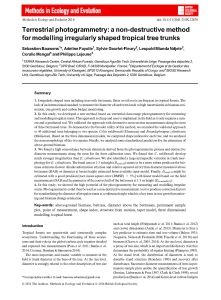Bauwens S., Fayolle A., Gourlet-Fleury S., Ndjele L., Mengal C., Lejeune P.
1. Irregularly shaped trees including trees with buttresses, flutes or stilt roots are frequent in tropical forests. The lack of an international standard tomeasure the diameter of such trees leads to high uncertainties in biomass estimation, tree growth and carbon budget monitoring.
2. In this study, we developed a new method based on terrestrial close-range photogrammetry for measuring andmodelling irregular stems. This approach is cheap and easy to implement in the field as it only requires a camera and a graduated rod. We validated the approach with destructive cross-sectionmeasurements along the stem of three buttressed t ees. To demonstrate the broader utility of this method, we extended the validated approach to 43 additional trees belonging to two species: Celtis mildbraedii (Ulmaceae) and Entandophragma cylindricum (Meliaceae). Based on the three dimensional models, we computed shape indices for each tree, and we analysed
the stem morphology of the two species. Finally, we analysed some standardized predictors for the estimation of above-ground biomass.
3. We found a high concordance between diameters derived from the photogrammetric process and destructive diameter measurements along the stem for the three calibration trees. We found that C. mildbraedii develop much stronger irregularities than E. cylindricum.We also identified a large intraspecific variation in trunk morphology
for E. cylindricum. The basal area at 13 mheight (Darea130) seems to be amore robust predictor for biomass estimates (lowest Akaike information criterion and relative squared error) than diameter measured above buttresses (DAB) or diameter at breast height estimated from available taper model. Finally, Darea130 might be estimated with a good precision [root mean square error (RMSE) < 5%] with linear model based on the field measurements DAB and the perimeter of the convex hull of the buttresses at 13 mheight (Dconvhull130).
4. In this study, we showed the high potential of the photogrammetry for measuring and modelling irregular stems. Photogrammetry could then be used as a non-destructive measurement tool to produce correction factors for standardizing the diameter of irregular stems at a reference height which is a key issue in tree growthmonitoring and biomass change estimation.
Consultez la notice complète de l’article sur ORBi

